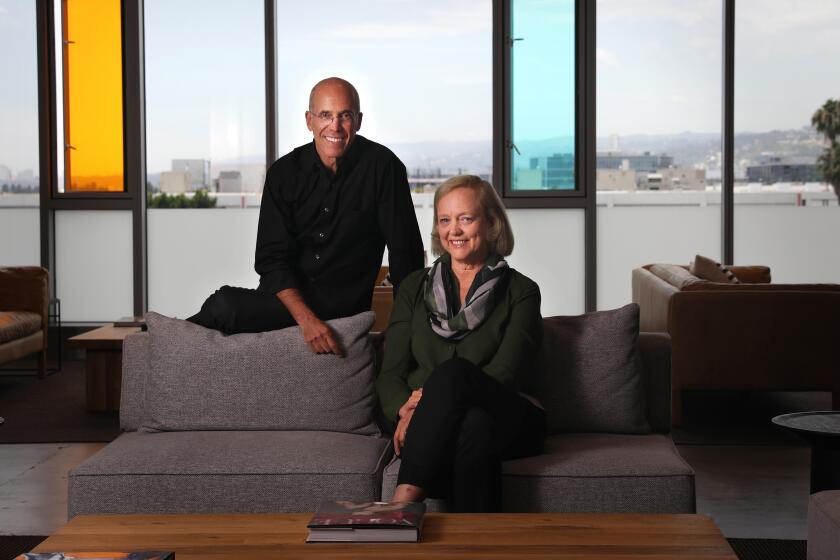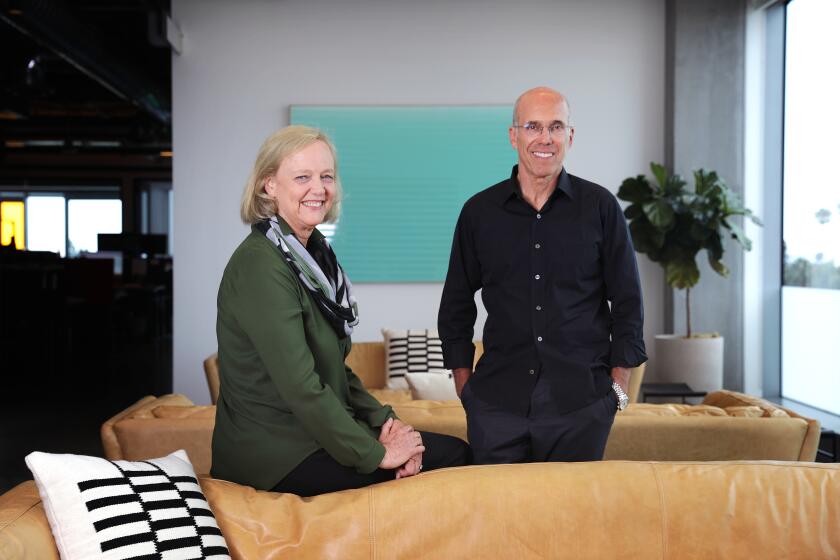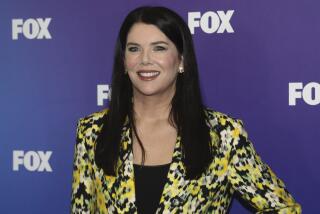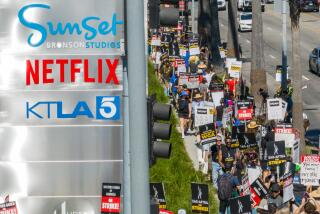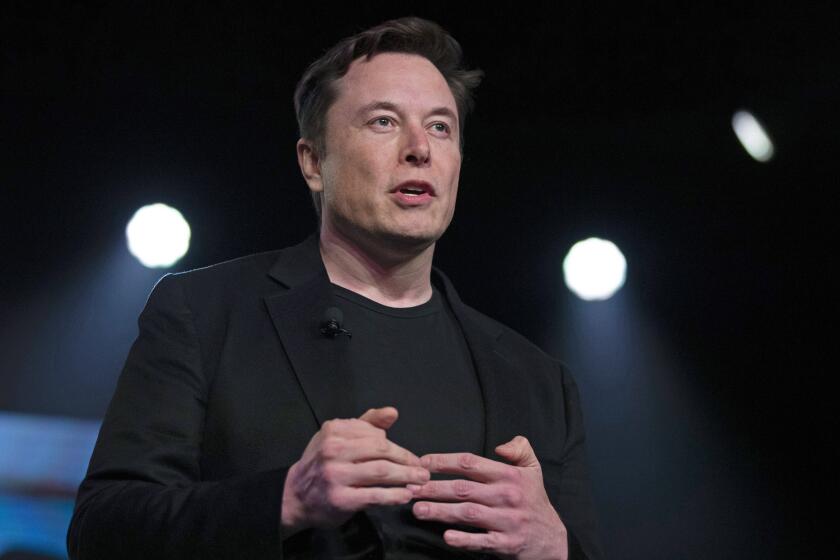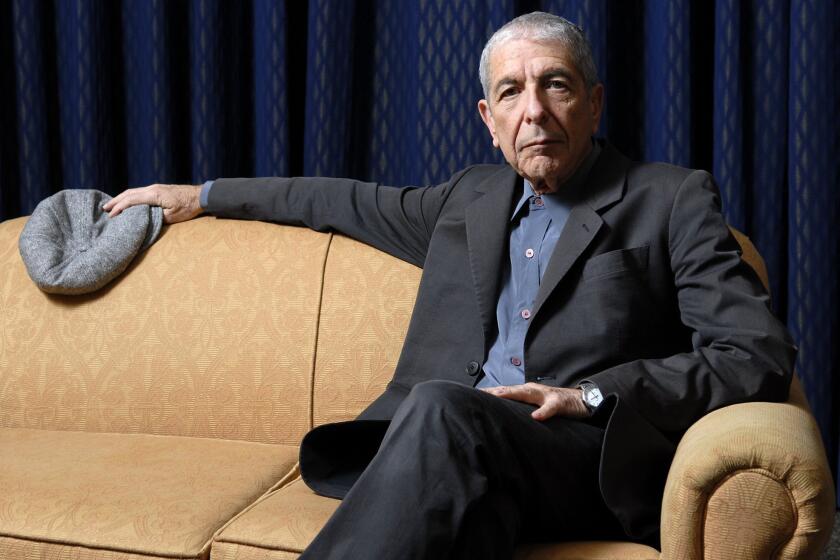The problem of selling Quibi: How marketing exposed division at the streamer

- Share via
Shortly after Jeffrey Katzenberg and Meg Whitman launched Quibi on April 6, it was clear something needed to change. The company had sold itself as the next big media brand but consumers were not taking the bait. App downloads were dropping fast and the name Quibi — which stands for “quick bites” — had become a running joke online.
Weeks after Quibi’s premiere, the company brought in marketing consultants to help salvage the short-form streaming service’s rollout, according to two people familiar with the matter who requested anonymity to protect relationships.
The marketing experts pitched multiple ideas to shake up Quibi’s approach. One plan was to heavily promote several marquee shows on the app, similar to how Netflix used “House of Cards” to legitimize itself.
But their suggestions were largely rebuffed by company executives, the knowledgeable people said. Katzenberg and Whitman still wanted to establish Quibi as a brand in and of itself and be a volume play, pushing many shows at once.
This key early challenge of Quibi — how to sell an unknown service to a mass audience — was the subject of much internal debate at the Hollywood-based company, people close to the startup said. The push-and-pull often reflected a generational divide between the top executives and the younger staff, many of whom were part of the demographic that Quibi was supposed to target.
“What happened was, they were too much trying to explain the service rather than saying this is the killer content that you need to have the app to see,” said Gene Del Vecchio, an entertainment marketing expert who teaches at USC’s Marshall School of Business and has no relationship to Quibi.
Quibi did not make any executives available for comment. The company defended its marketing approach, saying it wanted to gather data on what shows customers responded to before launching full marketing efforts for those titles. In response to a question about its culture, the streamer cited dozens of public posts on LinkedIn from employees writing about their positive experiences there.
Quibi did create campaigns around individual shows after its launch, including for a wide range of series and movies such as “Most Dangerous Game” and “#FreeRayshawn,” which won two creative arts Emmys in short-form acting categories in September.
It was too little too late. On Oct. 21, Quibi announced it was shutting down just over six months after launching. Quibi, which employed 265 as of April, said it would cease operations, return $350 million to investors, and sell off assets.
There were early signs of trouble even before the app’s launch. While some high-profile executives joined Katzenberg’s crusade to bring Hollywood production value to short-form video, many questioned the idea from the start.
Katzenberg, the former DreamWorks Animation chief executive known for his tireless work ethic and salesmanship, would pitch the idea relentlessly at lunches and meetings.
“It was all-consuming for him,” said one executive who knows Katzenberg. “It was pitching nonstop.”
Many industry analysts questioned Katzenberg’s idea to charge for short videos that subscribers would watch during “in-between moments,” such as while standing in line for coffee. Young adults and Gen Z consumers already had YouTube, TikTok, Twitter and Instagram for that. They were perplexed by Katzenberg’s idea to make “movies” on Quibi, broken up into “chapters” of roughly 10 minutes each. If people wanted to watch a movie in segments, they could just hit “pause” on the Netflix app, they said.
Whitman, speaking at January’s CES show in Las Vegas, acknowledged that building an audience for Quibi would not be easy.
“My view is we are launching a new consumer service, which is going to take time to build,” Whitman, the former chief executive of Hewlett-Packard Co. and EBay Inc., said in an interview. “No one’s ever heard of Quibi, we have to explain the use case.”
To that end, the company spent millions on outdoor advertisements and TV commercials to sell the Quibi concept.
The startup deployed $63 million on TV, digital and print ads this year, making it the fifth-biggest advertiser in streaming, according to MediaRadar, a New York firm that tracks ad spending. A 30-second Super Bowl spot that cost $5.6 million showed a team of bank robbers whose getaway driver is delayed because he’s watching a Quibi show.
“I’ll be there in a Quibi,” says the driver while staring at his smartphone screen.
“A what?” a confused robber yells through his walkie.
“A Quibi. Less than 10 minutes.”
A video introducing the ad on social media also leaned into the weirdness of Quibi. The video featured “Jimmy Kimmel Live” correspondent/security guard Guillermo Rodriguez comically struggling to pronounce the service’s name.
It wasn’t just Guillermo who found the Quibi name confounding. Shortly before launch, the company conducted market research that came back saying that a substantial number of respondents thought “Quibi” was the name of a food delivery service, according to one person briefed on the research who was not authorized to comment. Quibi denied that characterization, first reported by New York Magazine, calling it inaccurate.
But some believed in Quibi’s pitch, which positioned Katzenberg and Whitman as the marriage between Hollywood and Silicon Valley. In the lead up to Quibi, Katzenberg touted his ability to find popular content, while Whitman said her experience at Quibi was similar to when she ran EBay, which she joined when the ecommerce firm had only 30 employees and $4 million in revenue.
Anis Uzzaman, chief executive of Pegasus Tech Ventures, said he was impressed with major studios’ investments and advertisers’ commitments before Quibi launched.
“We could have tried some other things before giving up, so a lot of people, including myself, were shocked that the company decided to give up so fast,” said Uzzaman. His firm invested $35 million in Quibi and expects to get only about 20% to 40% of it back.
Jeffrey Katzenberg and Meg Whitman run Quibi, a digital platform creating bite-size shows for millennials to watch on their smartphones.
But Katzenberg and Whitman said they had little choice, citing a combination of bad timing and a core idea that wasn’t strong enough to survive as a stand-alone entity.
One of Quibi’s biggest challenges was competition from established brands with popular content and deep pockets. Multiple services have sprouted in the last year to attract audiences to their own platforms. Disney+ has more than 60 million paying subscribers since launching a year ago.
Netflix, which recently announced price hikes on its standard and premium plans, has 195 million global subscribers. NBCUniversal’s Peacock, which has a free ad-supported version, has clocked 22 million signups.
“The fact that we have such a deep library of familiar stuff, it’s kind of the opposite of Quibi,” said NBCUniversal Chief Executive Jeff Shell in an earnings call this week.
In that crowded environment, Quibi needed some megawatt shows to break through, Del Vecchio said, especially when it was asking people to pay $5 to $8 a month.
“No one knew what Quibi was, which was a problem, and it didn’t have the killer content, which you need, particularly when you’re late to the party,” he said.
More than two months after its launch, the much-hyped subscription service Quibi hasn’t lived up to its promise, analysts say.
Quibi’s marketing efforts also suffered from executive turnover. Brand and content marketing head Megan Imbres left the company in April, soon after launch. In an interview with the New York Times, Katzenberg cited a “difference of opinion about what the strategy would be going forward.” Imbres declined to comment.
Katzenberg brought in Ann Daly, a longtime ally, to take over marketing on an interim basis. Daly had previously worked with Katzenberg for years as president and chief operating officer of DreamWorks Animation. After DreamWorks, she joined Katzenberg’s holding company WndrCo. as a co-founder.
From the beginning, Katzenberg presented Quibi as employing mostly young people — with 82% of its staff 40 years old or younger— and empowering them to pick content their peers would like.
But there were frustrations among people who worked on Quibi shows and customers about how the app was designed. When it first launched, the app did not have a feature for people to share screenshots on social media, or project programs onto TVs, making it difficult to share the content.
Quibi said these features later became part of the app and followed the natural progression of any new technology platform.
“They put themselves into a bit of a corner, the product wasn’t really engineered to be widely distributed and shared,” said Larry Adams, chief executive of LVA, a New York-based agency. “Where people really find out and discover content is when they hear about it from friends, not necessarily always from watching it on a Super Bowl ad.”
Quibi tried to pivot. The streamer began making several episodes available on YouTube at the end of April. And in August, it launched a free, ad-supported version of its service in Australia and New Zealand.
Near the end of Quibi’s run, there appeared to be some reason for hope — the two Emmy wins for “#FreeRayshawn,” starring Laurence Fishburne, Stephan James and Jasmine Cephas Jones. The awards success of the show, along with Quibi’s 10 total Emmy nominations, finally gave Quibi something to brag about.
Any boost was fleeting.
A month later, Katzenberg and Whitman held separate meetings for investors and staff to announce they were shutting Quibi down. Many found out about the decision through media reports.
The app will end its service Dec. 1.
More to Read
Inside the business of entertainment
The Wide Shot brings you news, analysis and insights on everything from streaming wars to production — and what it all means for the future.
You may occasionally receive promotional content from the Los Angeles Times.
